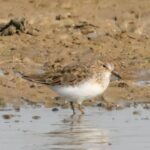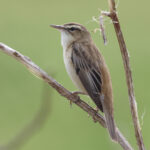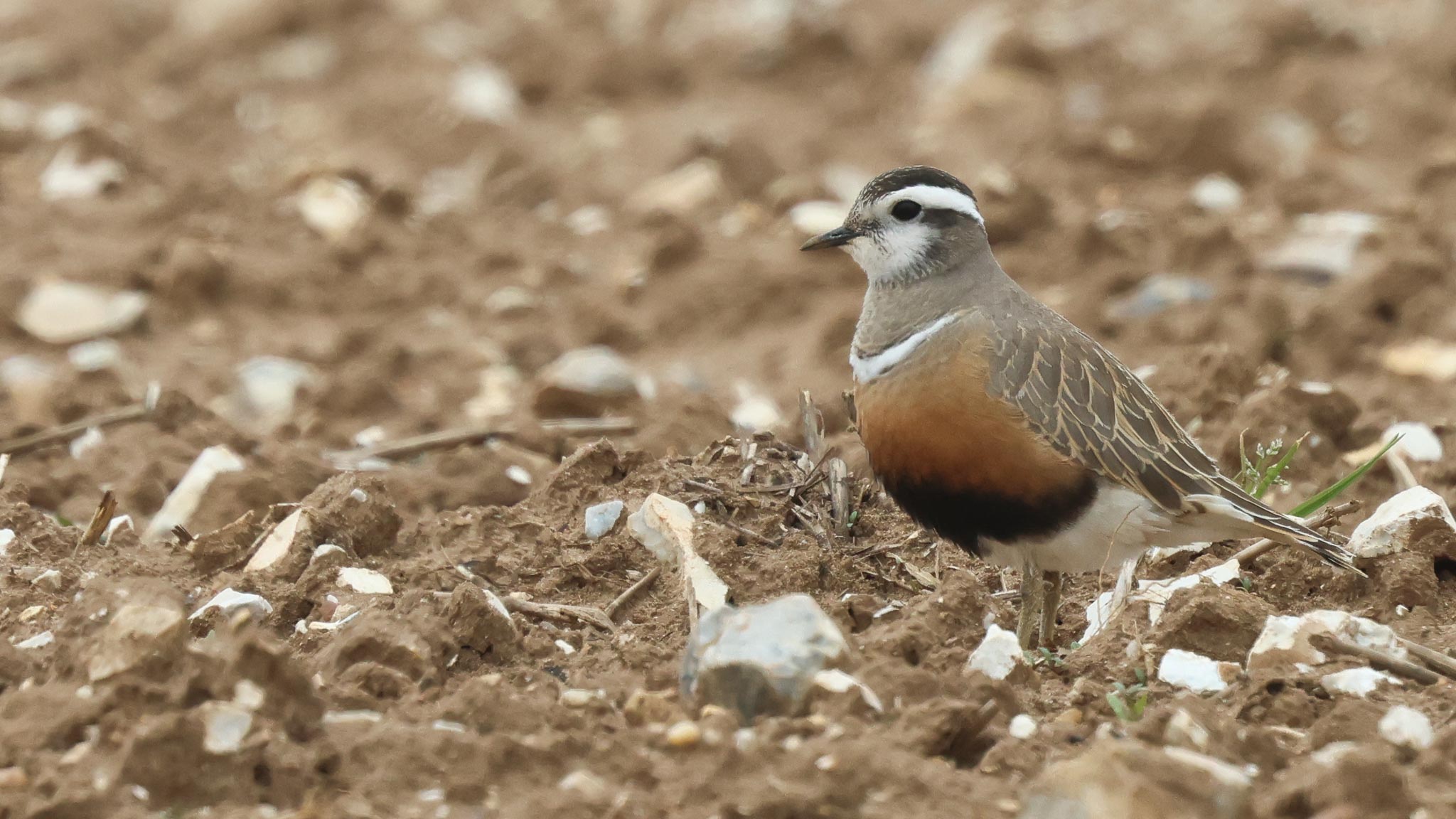Day 3 of a three day Autumn Tour & Wader Spectacular, our last day. It was a cloudier day today, though still dry, and the wind though still fresh and from the NE, was perhaps not quite as strong as it had been. Today we would be heading up to the Wash for the Wader Spectacular at Snettisham.
It was an early start to catch the tide, but as we were driving up to Wells to pick the rest of the group up, we found a car across the road with its hazard lights on. We thought there might have been an accident or something, but a woman got out and explained they had decided to close the road to move static caravan. It was obviously not official, and they hadn’t sought any permission to close the road so we were not sure how legal it was, but there was no time to argue and no choice but to go the long way round. The woman just shrugged and gave us a sheepish smile. Consequently, we were slightly later than planned getting away.
On the drive across to the Wash, we passed several large skeins of Pink-footed Geese flying inland to feed, coming up from the marshes where they had spent the night. There was flocks of Rooks and Jackdaws in the fields and a Barn Owl on a post by the road, but we had no time to stop now.
When we got to the Wash and up onto the seawall, the tide was already coming in fast, pushed in ahead of time by the fresh NE wind. We made our way straight down to Rotary Hide today, and stopped in front to scan. Huge flocks of Knot and Oystercatchers were gathered out on the mud, along with smaller numbers of Bar-tailed Godwit and Grey Plover.
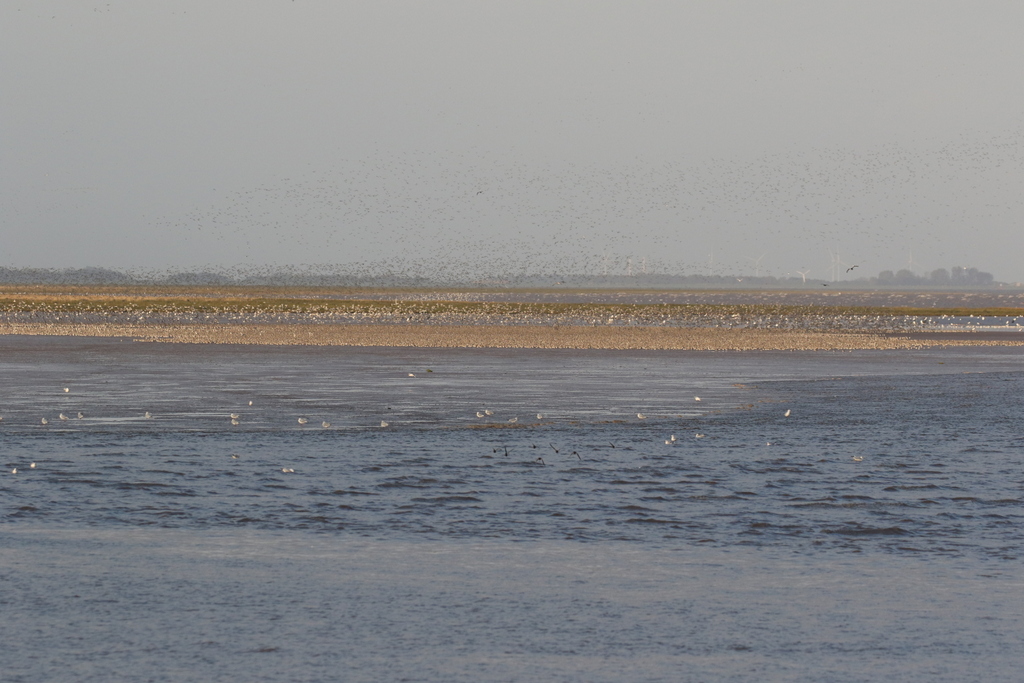
The waders were all shifting nervously, whether driven by the rapidly rising tide or perhaps there had been a predator around normally. There were no small waders down on the near edge today. The Knot on the edge of the flock out in the middle, those closest to the water, were constantly being caught by the tide and they kept flying up and over the others, landing again on the drier mud higher up.
As we walked down towards the far corner of the Wash, it was a struggle to keep up with the tide today. We did keep stopping to watch every time the waders went up. The Oystercatchers started to give up first, flying up in big groups and in overhead calling noisily, before circling down onto the pit behind us.
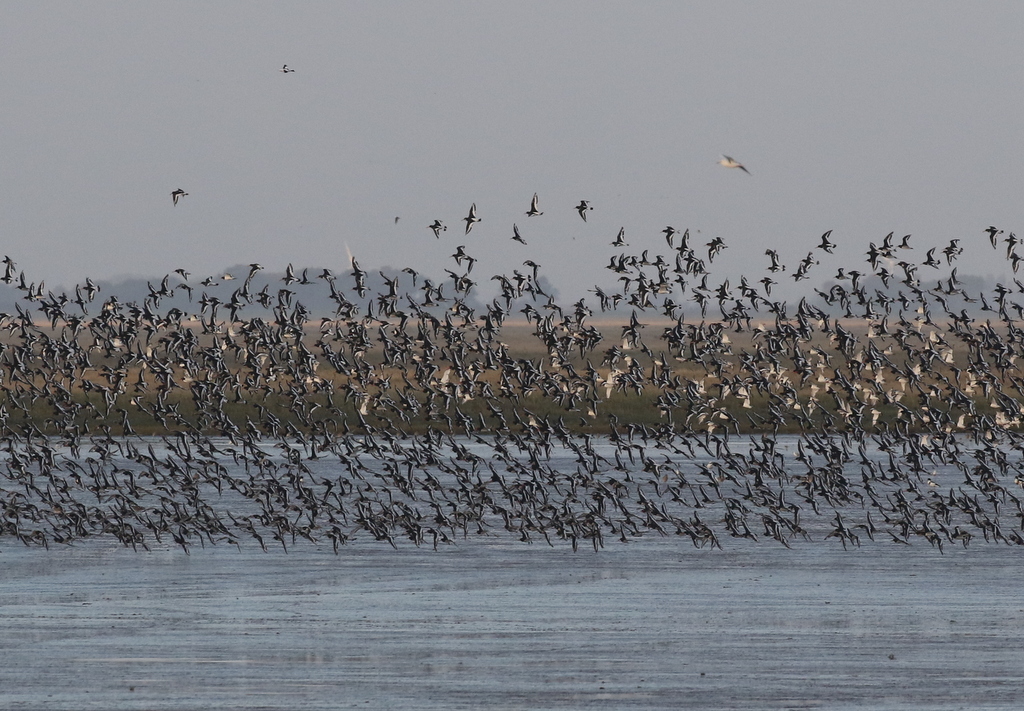
Before we could even get to the corner, suddenly all the Knot and other waders went up. We couldn’t see any sign of the Peregrine, but they were definitely nervous and put on quite a show, whirling round out over the Wash. The latest WeBS count total of Knot this week was 68,000 – incredible to see them all in the air together.
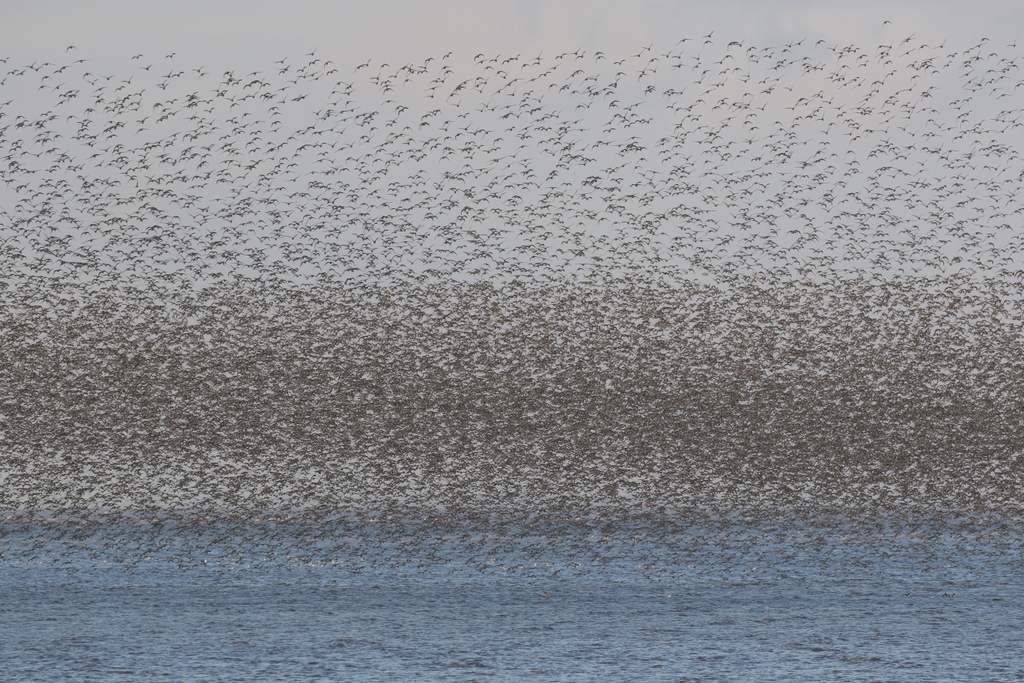
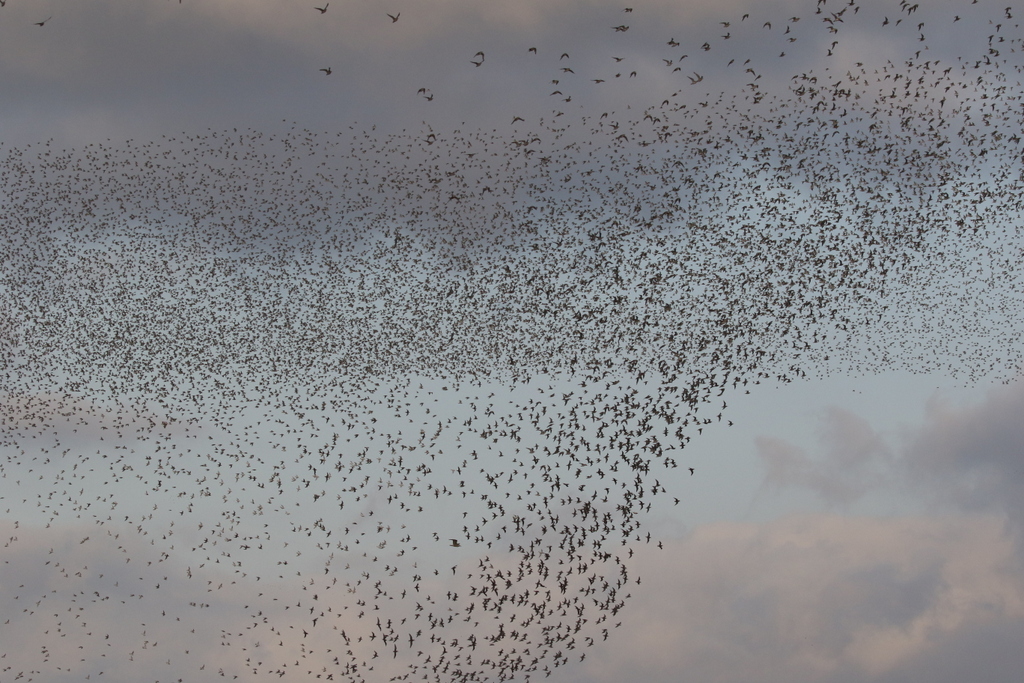
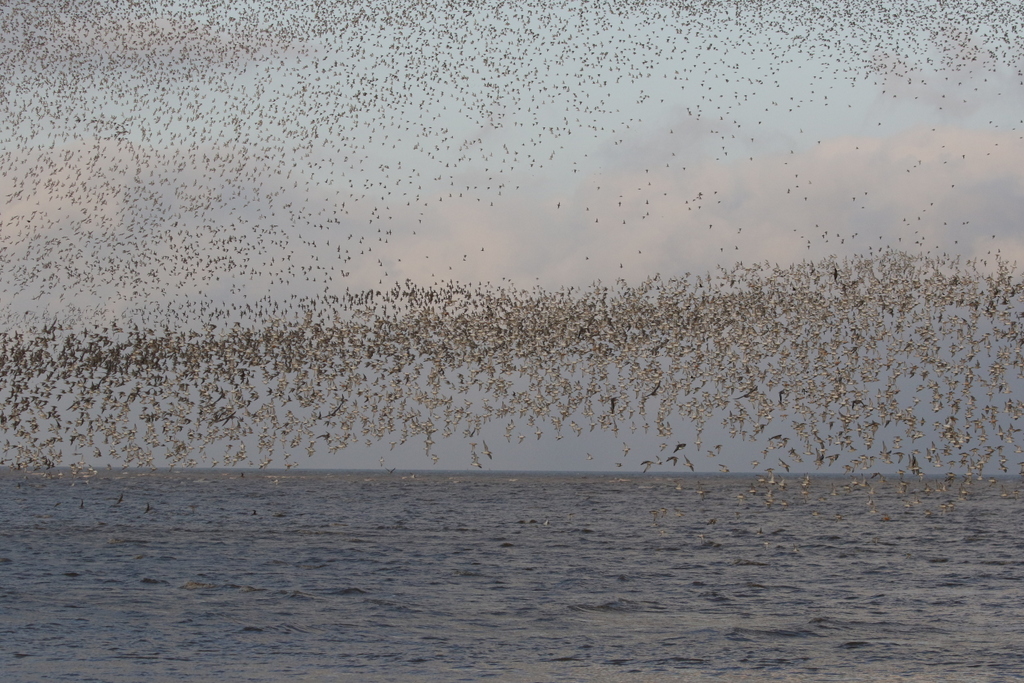
It was amazing to watch all the Knot and other waders up in the sky. Some tried to land back on the mud, but were immediately spooked again. Different flocks were going in different directions. Despite the wind, we could hear was the beating of thousands and thousands of pairs of wings. Some of the Knot started to come in, low overhead – mesmerising to look up and watch – while others towered up over the Wash.
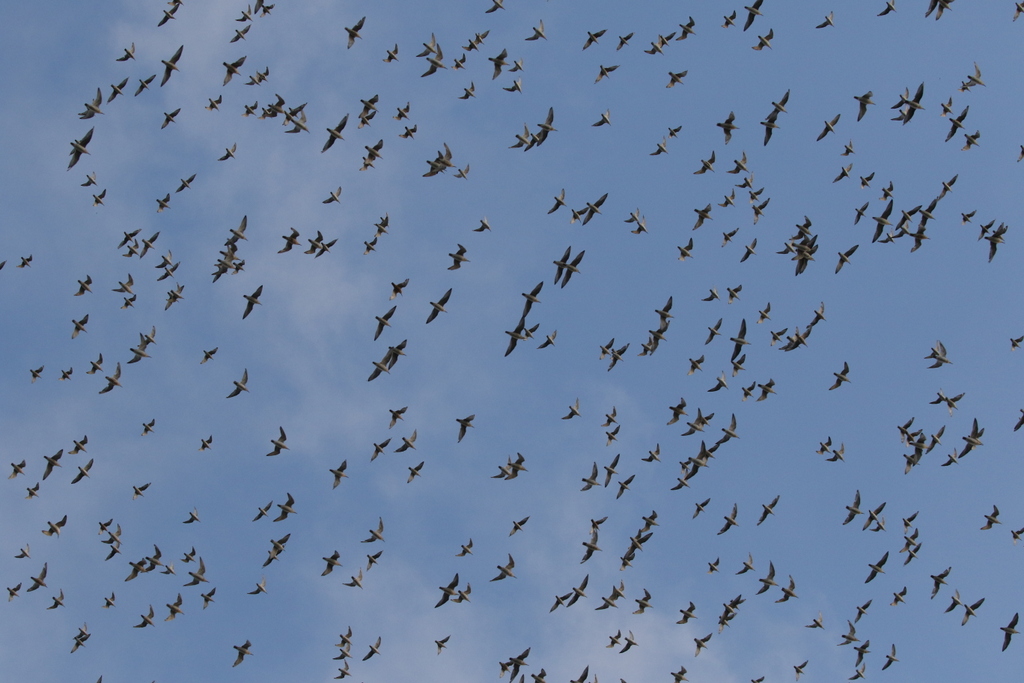
We turned to watch the Knot coming in and start to drop down onto the pit, but for some reason they wouldn’t settle on the south end today. We watched the birds flying round and round, backwards and forwards, low over the pit in front of the new hide, ‘Knots Landing’ (or ‘not landing’ today!). The birds which had gone high turned back out over the Wash. Some of the others went back out and landed again in the final corner of mud.
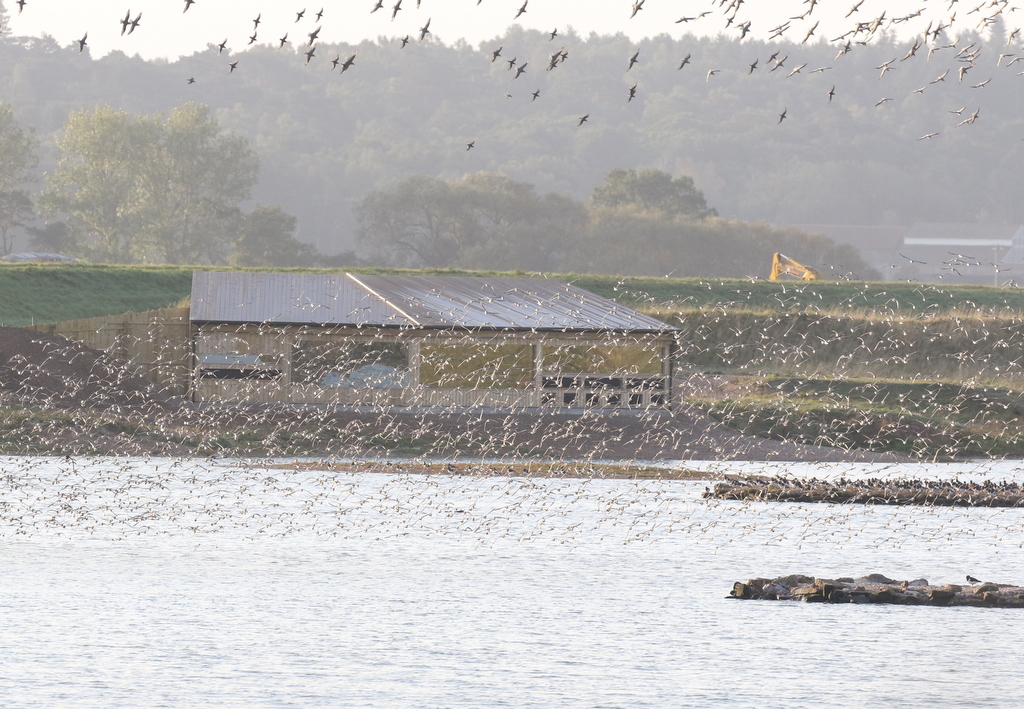
We walked on down to the end. Those Knot which had landed again were quickly forced off, and came in over us again. Tens of thousands were still towering high in the sky. Small flocks of Dunlin flew past out over the Wash, presumably now looking to roost along the shore further up.
There was now nothing left out on the Wash and any remaining mud was covered with water. There were still huge flocks of Knot high in the sky, but we decided to go into the hides to see what was on the pit.
Shore Hide was empty – everyone had gone down to see the new hide. Five Spotted Redshanks were roosting on the concrete blocks out in the middle. We got them in the scopes – one was helpfully awake and we could see its long spiky bill with a needle-fine tip. A juvenile Common Tern was still lingering here, standing on one of the other concrete blocks nearby.
A Little Stint landed on the shore of the shingle island in front of the hide. There was nothing else on there today, and we watched it picking around on the shore between the blobs of foam. It was a juvenile – we could see its distinctive pale ‘braces’. After a while it flew off again. Then a Common Sandpiper landed on the island next and walked around on its own in the middle for a bit.
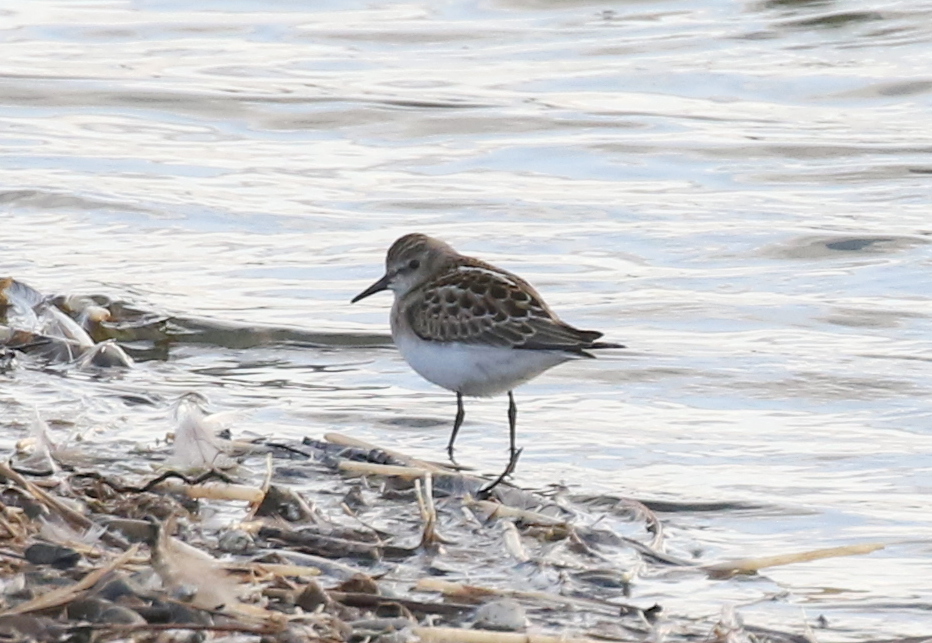
Scanning the islands further up the pit, there were next to no Knot on any of the islands closest to the seawall today. Only one of the islands across on the other side of the pit was packed shoulder to shoulder with them. A lot of Dunlin (mostly) on one of the nearer islands was more socially distanced. We scanned through, to see if we could find anything more unusual in with them, but couldn’t find anything today.
Looking towards the south end, we could see that the Knot which had come in today were concentrated on the bank, with the Oystercatchers. They were still shuffling nervously.
As we walked round to South Hide, a young Peregrine circled overhead and gradually drifted out over Wash. Perhaps this is why everything was so nervous today. We watched it stoping down, flushing all the Curlews and godwits from out on the saltmarsh. There was a lot of water on there today, with only the taller bushes and higher islands still exposed – a combination of the big tide, backed by the blustery NE wind. Three Marsh Harriers were hunting out over the Wash further back too.
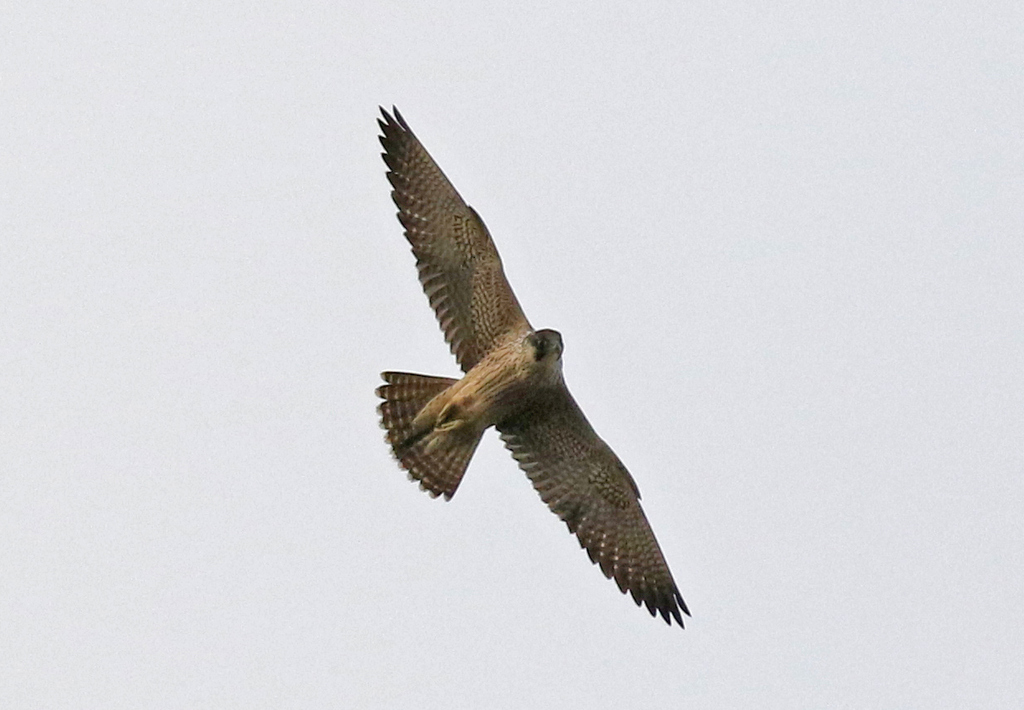
With social distancing restrictions in force, we had to wait to get into South Hide today, but thankfully not long. When we donned our masks and got inside, we found the two shingle islands at this end still mostly empty. One Little Stint and a small cluster of Knot was on one, but that was it. Two Common Sandpipers flew round calling below the hide.
Most of the Knot were still on the bank. We watched them jostling nervously. They would settle for a bit, then one end would start to move and a wave would pass through the flock.
We went round to have a look at the new hide, ‘Knots Landing’. It was largely empty now apart from a line of photographers in the corner, packed shoulder to shoulder, lying down at the low camera windows. Every time the Knot on the far bank flew up, there was a cacophony as a barrage of camera shutters fired in unison. Perhaps the amount of noise was putting the birds off from landing on the closer islands?
Two Little Stints and the two Common Sandpipers were now running around on one of the islands. A single Avocet was roosting in with the Oystercatchers gathered on one end, a different variation in monochrome. The last bird in the flock, standing in the water at the end, was a smartly marked juvenile Bar-tailed Godwit.
A line of Knot peeled off from the bank and headed back out. It was an hour after high tide already, so we figured we should go outside and back round to the bank to try to catch the birds as they returned to the Wash. But when we got out, there was still no sign of any mud. With the wind and the amount of water today – the path was even flooded in one spot now – the tide was going to be really slow to go out. The Knot which had come up off the bank flew straight back in and dropped down again in to the pit.
Still, we walked down to the edge of the Wash and got into position. We didn’t have to wait too long before some mud started to reappear in the top corner and once it started, the tide began to go out as quickly as it had come in.
Finally, the Knot started peeling off from the pit again. We were in the perfect position, and they came low in lines making a beeline for the mud, came right over our heads.
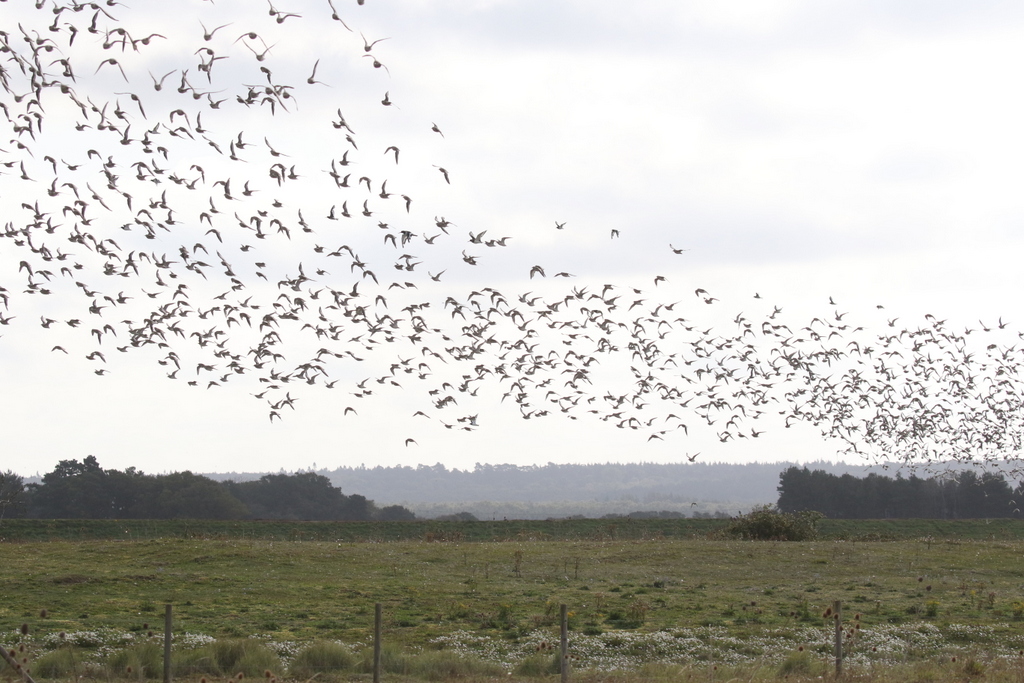
Suddenly we heard a loud whoosh and a larger group came up and flew out towards us. The young Peregrine was over the pit, and spooking everything. We watched it stoop down a couple of times towards the bank, but it didn’t have any height and it looked like it didn’t quite know what to do. It flew further up the pit and flushed all the Knot from the island that end too. We watched as they flew out in lines, low over the bank and out onto the Wash.
The Knot quickly settled in big groups out on the mud, but then the Peregrine circled up from the pit and drifted out over the Wash. Instant pandemonium – the waders all erupted again, taking off, whirling round. The flocks made some amazing shapes, as they twisted and turned, alternately flashing dark and light.
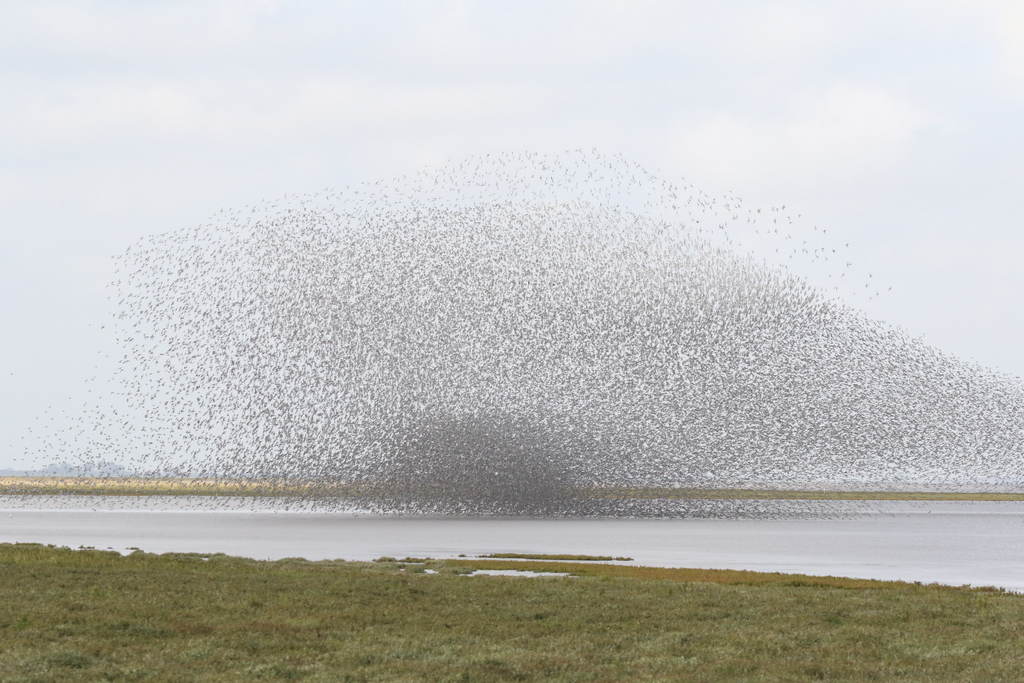
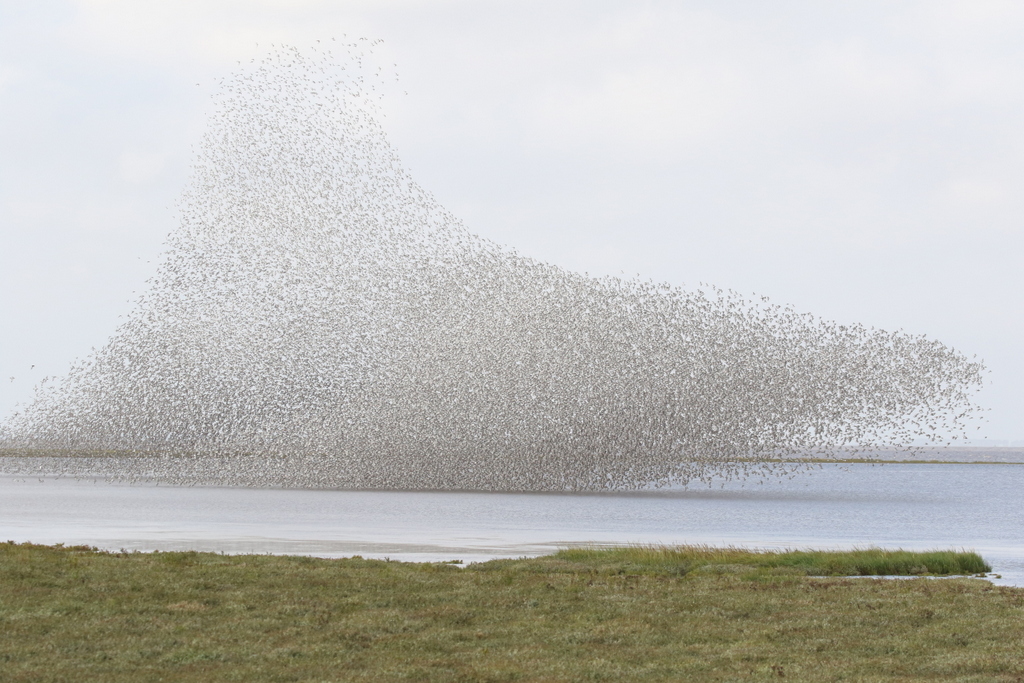
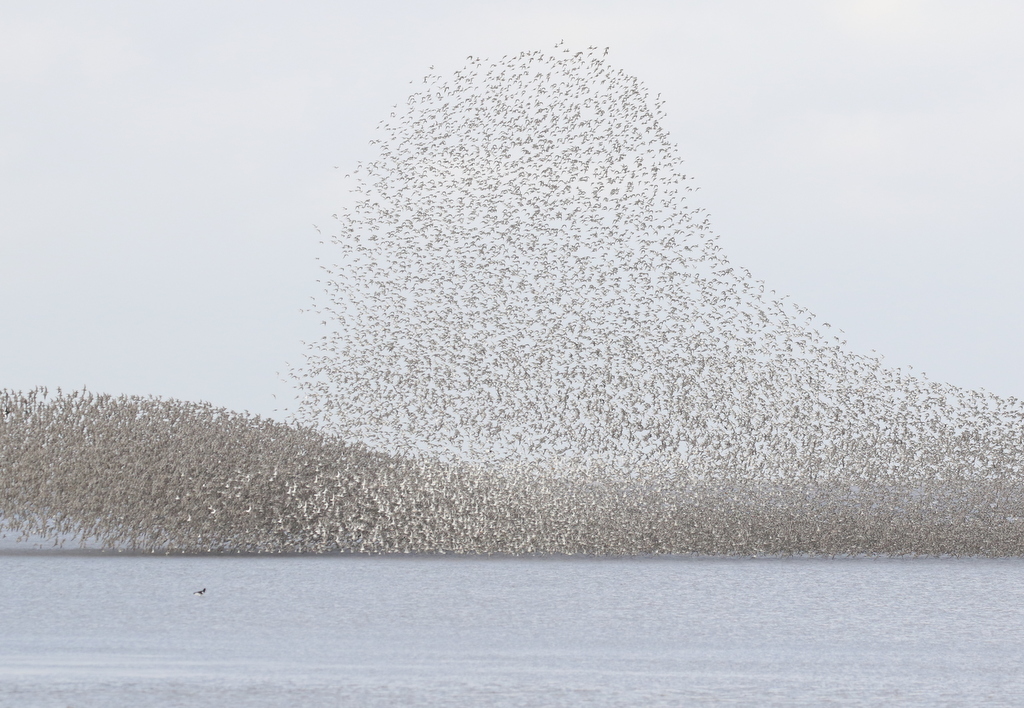
The Peregrine appeared to successfully get one separated from the flock at one point, but despite chasing after it, it lost it. Again, probably showing its inexperience. A second Peregrine appeared further back, flushed everything behind. It was an amazing show, truly spectacular, and we were endebted to the Peregrines for stirring everything up. We just stood and watched transfixed, to the sounds of the flocks’ wings and oohs and aahs from the crowd.
The waders eventually resettled on the mud, as the Peregrines drifted off. We started to scan through the flock nearest to us. There were several pale silvery grey and white Sanderlings with the Knot now, and the very last bird on the end was a lone juvenile Curlew Sandpiper. We could see the pale peachy wash on its breast and its long downcurved bill.
We could still see an adult Peregrine, on a post in the distance, on the saltmatsh beyond the mud. The waders much further back, in the next bay, were still being stirred up. Presumably the juvenile Peregrine was trying its luck back there now. The waders this end were mostly settled, and started to go to sleep. Occasionally a flock would take off and fly further out across the mud, twisting and turning, catching the sun which had started to come out now.
As we turned to head back, a shout went out and we looked out across the Wash to see a Great Skua flying low over the water beyond the flocks of waders.
We planned to spend the afternoon at Titchwell, but we had to take a diversion inland to get there. There was so much traffic on the coast road, it had back up from the traffic lights at Heacham. Unheard of in late September, it was like midsummer! The car park at Titchwell is still partly closed and once again was full – they were only letting one in and one out. We were lucky to arrive just as someone was leaving and get straight in.
We decided on an early lunch in the picnic area. A Marsh Harrier drifted overhead and a Common Darter was basking on the bench in the sunshine. After lunch, we headed out on to the reserve. We could hear Siskins calling in the trees as we filled out the test and trace form at the Visitor Centre.
Thornham grazing marsh was flooded with saltwater where the pool used to be, after the high tide had come in. A single Stock Dove was out in the vegetation and several Curlews were feeding on the saltmarsh beyond.
A large mob of Greylags was on the Reedbed Pool, but scanning through we managed to find a few Common Pochard in with them, and Coot and Little Grebes right at back. A pair of Gadwall was in the channel just beyond.
A young Hobby was hunting low over the reeds, out in the middle, shooting back and forth. It caught something, presumably a dragonfly, and circled up over the trees by the visitor centre. A Sparrowhawk emerged from the trees and chased after it, presumably trying to steal its catch. It was quite a dogfight for a bit, amazing to watch, before the Sparrowhawk gave up. The Hobby finished its meal and we watched it hunting over Willow Wood at the back of the reedbed.
Up by Island Hide, we could hear Bearded Tits calling in the reeds, but it was still rather windy and they were keeping well down today. We stopped to scan the Freshmarsh from the bank further up. There were not as many waders on here today. A few Avocets were still here, feeding over towards the back, along with several Black-tailed Godwits. Quite a few Ruff, paler adults and browner juveniles, were closer to the bank. Otherwise, there were a couple of Dunlin and two Golden Plover on one of the islands, in with the Lapwings and Black-headed Gulls.
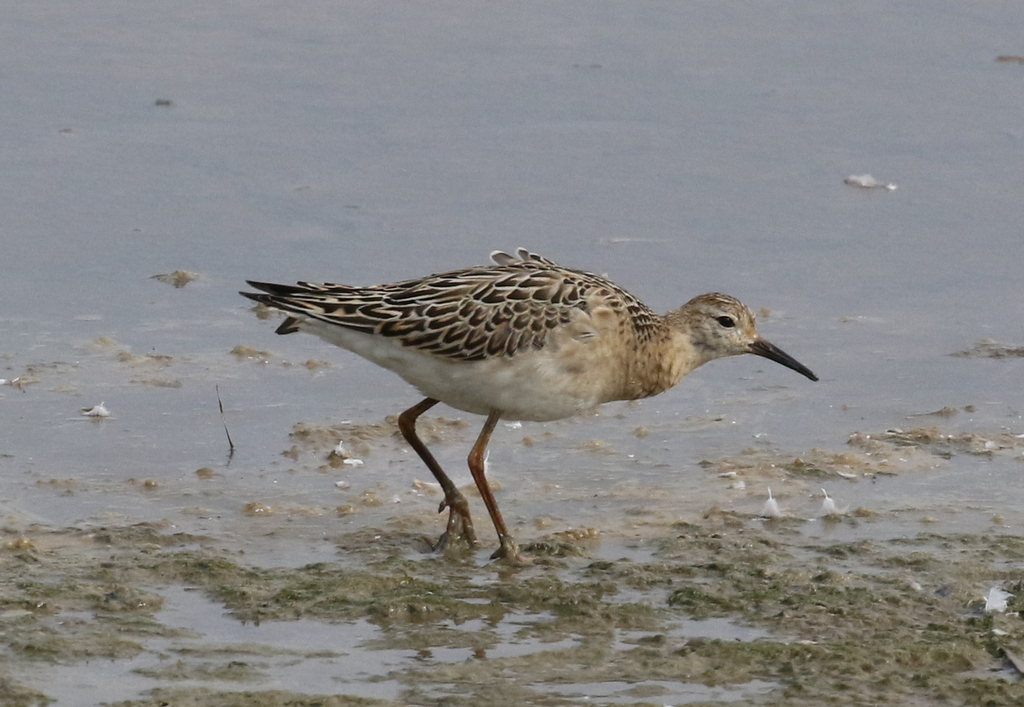
There are more ducks on the Freshmarsh now as birds return for the winter, Wigeon, Shoveler, Teal, and more Gadwall. They are not looking their best at this time of year though – with the drakes mostly in their dull eclipse plumage.
A Grey Heron was standing motionless, fishing out in the middle of the deeper water towards the back. Next time we looked, there was a Great White Egret next to it. It was good to see the two of them side by side, so we could really appreciate the large size of the Great White Egret.
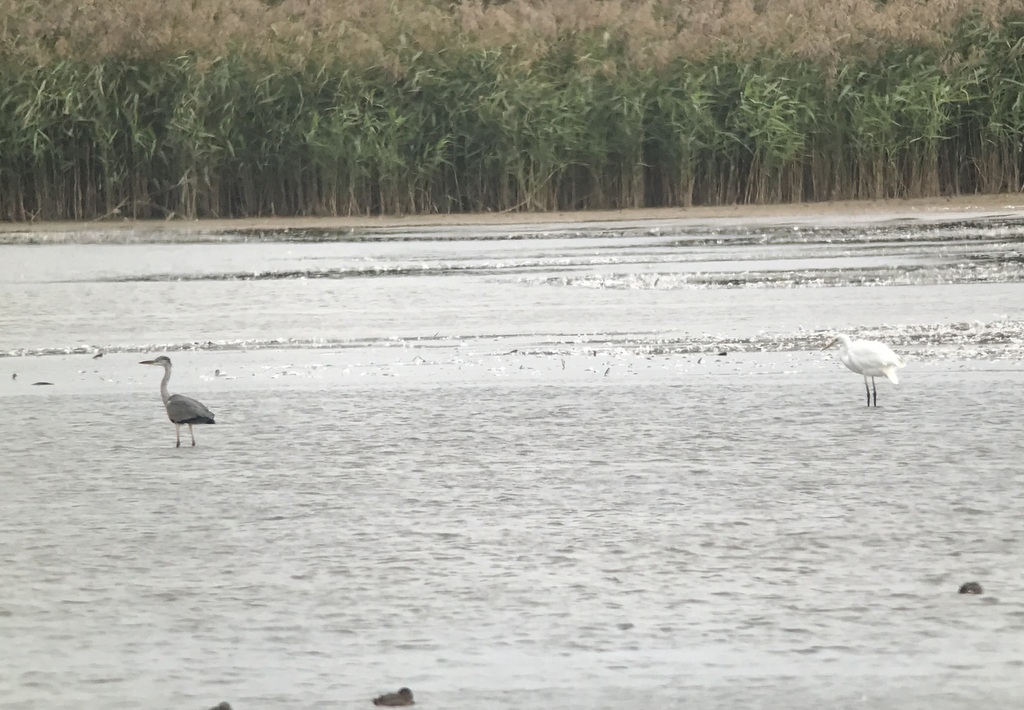
There had been some Lapland Buntings on the beach this morning, and someone walking back now told us they were still there, although they had apparently flown up the beach a bit further along to the west. We decided to go to try to look for them.
There was not much on Volunteer Marsh as we passed, just a few Curlew and Common Redshanks on the mud by the channel at the far end. A lone Brent Goose flew over. There was still a lot of water on the Tidal Pools, despite it being close to low tide now, and not much on here either.
The tide was a long way out when we got to the beach, and we couldn’t see anything obvious on the sea. There were lots of people around the mussel beds and not many waders. We set off west along the tide line. Unfortunately there was no sign of any buntings now. Several beachgoers were walking out here, and presumably they had been flushed.
We continued on up to Thornham Point, where we found a little group of Sanderling, Ringed Plover and Dunlin on the beach. A party of Brent Geese was loafing out on the sand closer to the sea. Rounding the corner, we found several Spoonbills out in the middle of Thornham Harbour. Two flew off as we appeared, but there were still seven preening out on the saltmarsh.
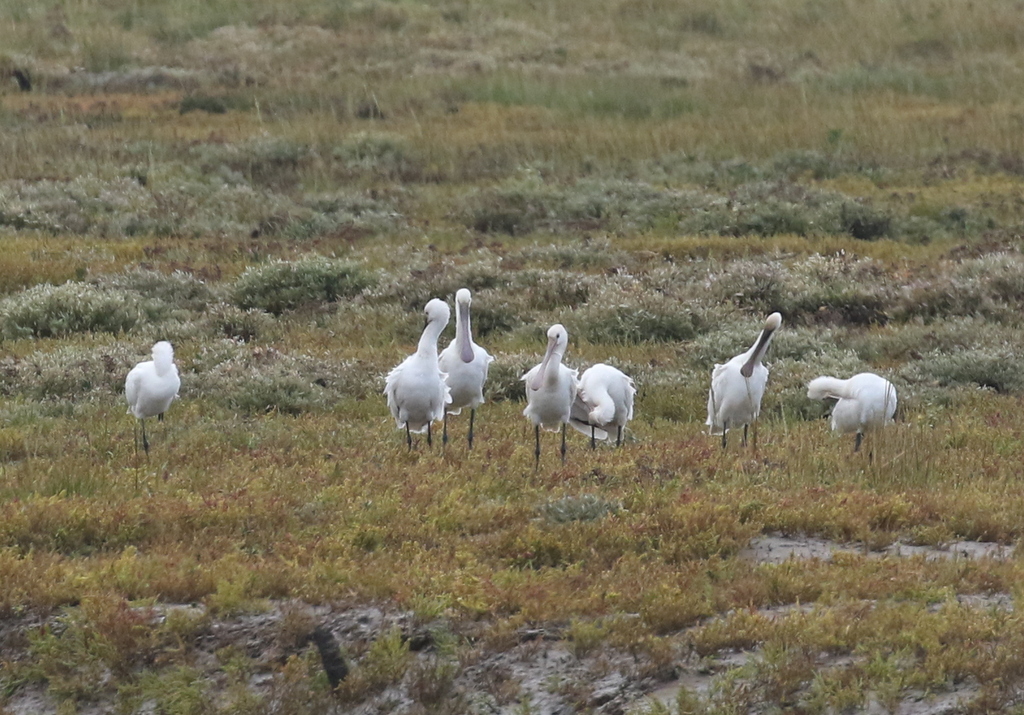
It was time to head back now – after a very early start, everyone was tired now and still had journeys home ahead of them. The memories of this morning’s Wader Spectacular would linger long, a great final day to end the tour.



